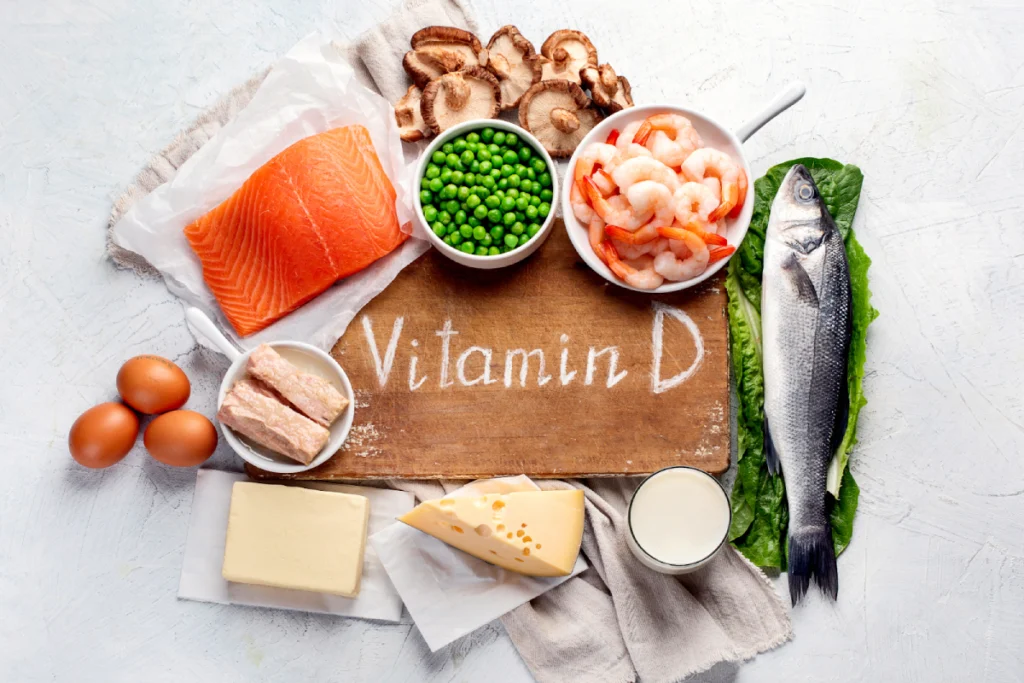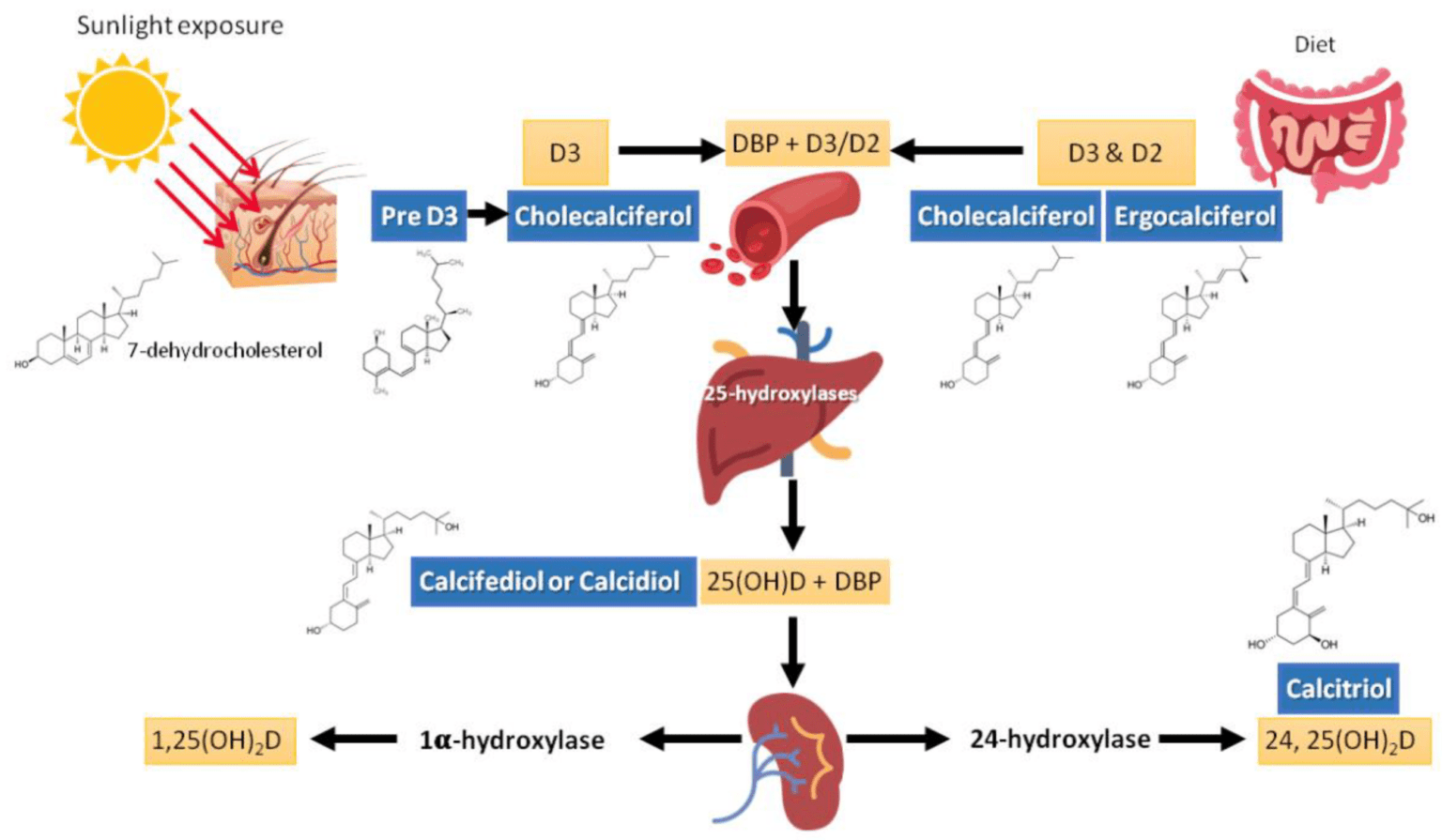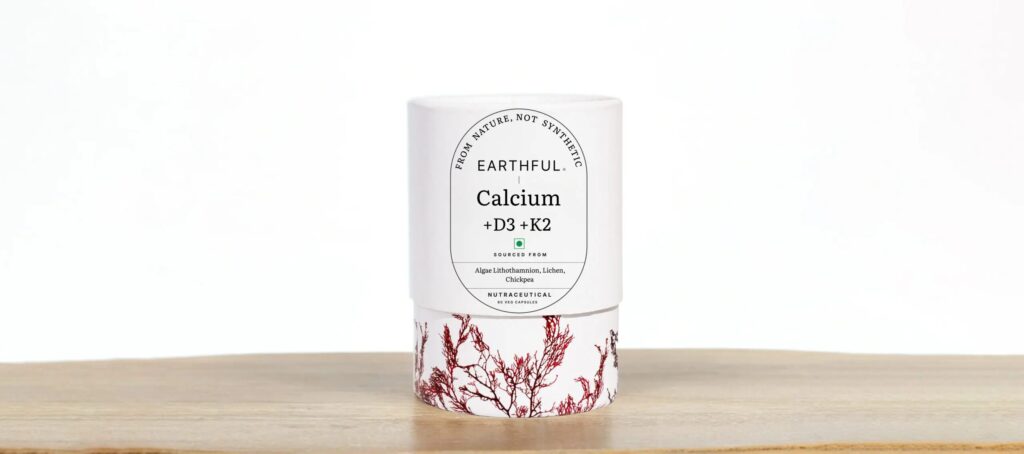Vitamin D3 or Vitamin D2? The Superior Choice Explained

When it comes to our health, vitamin D often doesn’t get the attention it deserves. Yet, it plays a crucial role in everything from our bones and muscles to our immune system. Unfortunately, vitamin D deficiency is alarmingly common worldwide, primarily due to lifestyle factors and limited sun exposure. In this deep dive, we’ll navigate the two main forms you might encounter: vitamin D2 (ergocalciferol) and vitamin D3 (cholecalciferol). We’ll explore what these two forms are, where to find them in food, the latest research, and tips on picking the right supplement. So, let’s shed some light on this vital nutrient.
Table of Contents
A Quick Refresher: What Vitamin D Does in the Body?
Vitamin D is a fat-soluble nutrient that acts like a hormone in the body, playing a crucial role in keeping bones strong, supporting muscle performance, regulating immunity, and maintaining overall metabolic balance. It helps the body absorb calcium and phosphorus, strengthens the skeletal system, reduces inflammation, and even influences mood and energy levels. Because it is involved in so many essential processes, maintaining optimal levels is vital for long-term health and the form of vitamin D you choose can make a significant difference in how effectively your body uses it.
Quick primer: D2 vs D3, what’s the difference?
You might wonder why there are two different forms of vitamin D and what sets them apart. Let’s break it down in a straightforward way.
Vitamin D3 (cholecalciferol)
Vitamin D3 is the superstar among the two forms. It’s naturally produced by your skin when it’s exposed to sunlight, specifically UV-B rays. This is why spending some time outdoors can be so beneficial (just remember to wear sunscreen!). You can also find D3 in various foods like fatty fish (think salmon, mackerel, and sardines), egg yolks, and cod liver oil. For those of you following a vegan lifestyle, there are vegan D3 supplements sourced from lichen that can offer a plant-based option.
Vitamin D2 (ergocalciferol)
On the flip side, we have vitamin D2. This form is primarily derived from plants and fungi. Ever heard about mushrooms soaking up UV light? That’s how they produce D2, often used in fortifying foods and has been a reliable option for many years.
While both D2 and D3 can be converted in the liver to the same active form of vitamin D (25-hydroxyvitamin D), they do differ in some important ways. D3 tends to be more effective at raising and maintaining the levels of this active form in your bloodstream compared to D2.6
Food Sources: Where to Find D2 and D3
Knowing where to find these vitamins in your diet can make a world of difference, especially if you’re trying to ensure you’re getting enough. Here’s the breakdown:
Vitamin D3 sources (natural and fortified):

~ Fatty fish: Salmon, mackerel, sardines, and tuna are excellent natural sources.
~ Cod liver oil: A potent source, though its taste might not be for everyone!
~ Egg yolks: Especially from free-range chickens, these can provide a decent amount.
~ Fortified foods: Many dairy products and animal-based foods are fortified.
~ Vegan Options: Lichen-derived D3 supplements offer a plant-based alternative.
Vitamin D2 sources:

~ Mushrooms: UV-exposed mushrooms (like wild mushrooms or UV-treated varieties) are a great plant-based source.
~ Fortified plant milks and cereals: Depending on the manufacturer, these products may contain D2 or D3.
~ Nutritional Yeast: Some yeast-derived supplements may also contain D2.
Takeaway: Generally, it’s easier to get the more bioavailable D3 from animal sources. For our vegan friends, seeking out UV-treated mushrooms and lichen-derived D3 is your best bet. However, just food might not be sufficient, especially for those with limited sun exposure or pre-existing deficiencies, so supplementation could be a practical option.
What recent research says – the bottom line
The scientific community is always on the lookout for new insights, and the latest studies have revealed some interesting findings.
▪️D3 raises total serum 25(OH)D more effectively than D2: A meta-analysis of 20 studies in 2024 highlighted that D3 is significantly superior to D2when it comes to raising total serum 25-hydroxyvitamin D levels. In simpler terms, if you’re aiming to boost your vitamin D status, D3 is your go-to option.1
▪️D2 supplementation may lower circulating 25(OH)D₃ levels. A 2025 meta-analysis and related reviews reported that D2 supplementation sometimes produces reductions in measured 25(OH)D₃, which can blunt the total 25(OH)D response compared with D3.6
▪️Dose and dosing schedule matter. Another interesting twist is how dosing frequency and quantity might impact effectiveness. Some trials that used higher, intermittent doses of D2 showed transient effects, but when compared directly with daily dosing, D3 consistently outperformed D3 in maintaining levels of vitamin D.5
These findings do not imply that D2 is harmful; rather, it’s just less effective and less stable than D3. Historically, both forms have been utilized in public health settings, but for individuals looking to supplement, emerging evidence is increasingly leaning towards D3 as the more reliable option for re-establishing and maintaining adequate Vit-D levels.
How Vitamin D (Both D2 and D3) Is Processed in the Human Body
Understanding how vitamin D works inside the body helps explain why D3 performs better than D2. Even though both forms follow the same overall metabolic pathway, they behave differently at each step.
1. Absorption in the intestine
Whether you consume D2 from mushrooms or D3 from eggs, fish, or supplements, absorption begins in the small intestine.
▪️Vitamin D is fat-soluble, so absorption improves when taken with dietary fat.
▪️Once absorbed, both D2 and D3 enter the lymphatic system and then the bloodstream, carried by chylomicrons (fat transport particles).
Key difference: Studies show D3 is absorbed slightly more efficiently and remains in circulation longer, giving it a head start.
2. Transport through the bloodstream
After absorption, both D2 and D3 bind to a protein called Vitamin D-Binding Protein (DBP).
▪️DBP acts like a shuttle, carrying vitamin D to the liver.
▪️D3 has a higher affinity for DBP than D2, meaning it binds more strongly and is protected from rapid breakdown.
Why this matters: Because D2 binds more weakly, more of it stays “free” in the bloodstream and is broken down faster, leading to shorter-lasting vitamin D levels.
3. Liver conversion (first activation step)
In the liver, enzymes convert both D2 and D3 into 25-hydroxyvitamin D, also called 25(OH)D.
This is the form doctors measure in blood tests.
▪️D2 becomes 25(OH)D₂
▪️D3 becomes 25(OH)D₃
Although both forms are converted, 25(OH)D₃ is more stable and stays in the blood much longer.
4. Kidney conversion (final activation step)
Next, the kidneys convert 25(OH)D into the active hormone; 1,25-dihydroxyvitamin D, also called calcitriol. This hormone is responsible for vitamin D’s real work:
▪️Absorbing calcium
Vitamin D helps the intestines absorb calcium from the foods you eat, ensuring your body gets enough to support critical functions. Without adequate vitamin D, even a calcium-rich diet won’t translate into strong bones or proper mineral balance. This makes vitamin D essential for maintaining healthy calcium levels throughout life.
▪️Strengthening bones
Once calcium is absorbed, vitamin D helps deposit it into bones, improving bone density and structural strength. It also supports bone turnover, the natural process of breaking down old bone and rebuilding new bone. This balance reduces the risk of fractures, osteoporosis, and age-related bone loss.
▪️Supporting immunity
Vitamin D activates key immune cells like T-cells and macrophages, helping the body detect and fight infections more effectively. It also enhances the production of antimicrobial peptides, the body’s natural defense molecules. This results in a more responsive and balanced immune system.
▪️Regulating inflammation
Vitamin D helps keep inflammation under control by modulating how immune cells respond to stress, infections, or injury. It reduces excessive inflammatory signals while supporting protective responses. This makes it important for chronic conditions where inflammation is a driving factor.
▪️Influencing mood and muscle function
Vitamin D plays a role in neurotransmitter regulation, which can influence mood, emotional well-being, and stress response. It also improves muscle strength, coordination, and recovery by supporting calcium flow in muscle cells. Adequate levels are linked to lower risk of falls, fatigue, and muscle weakness.
Both D2 and D3 can technically convert into calcitriol, but…D3 -derived calcitriol maintains stable levels for longer, while D2 -derived active hormone drops sooner.
5. Utilization in tissues
Active vitamin D (calcitriol) then travels throughout the body:
▪️Intestines: increases calcium & phosphorus absorption
Vitamin D helps the intestinal lining absorb calcium and phosphorus more efficiently, ensuring the minerals you eat are actually used by the body. This process is essential for maintaining strong bones, proper nerve function, and stable muscle contractions.
▪️Bones: supports remodeling and strength
Vitamin D works with calcium to support continuous bone remodeling, breaking down old bone and rebuilding new, stronger tissue. Adequate levels reduce the risk of fractures, osteoporosis, and age-related bone loss.
▪️Immune cells: modulates inflammation
Vitamin D interacts with immune cells such as macrophages and T-cells to help regulate inflammatory responses. It strengthens the body’s defense against infections while preventing excessive or chronic inflammation.
▪️Muscles: improves strength and contraction
Vitamin D enhances muscle fiber function and improves the efficiency of muscle contractions. Adequate levels are linked to better balance, reduced fall risk, and improved strength and performance.
▪️Hormonal balance: influences insulin and stress response
Vitamin D plays a role in regulating insulin secretion, making it important for metabolic health and blood sugar control. It also interacts with hormones involved in the stress response, supporting mood stability and overall endocrine balance.
Because D3 results in higher and more sustained 25(OH)D levels, tissues receive a more steady supply of the active hormone.
6. Breakdown and half-life: the biggest difference
This is the strongest functional distinction:
25(OH)D₃ (from D3)
- longer half-life (2–3 weeks)
- stays stable in blood
- gives consistent vitamin D status
25(OH)D₂ (from D2)
- shorter half-life
- degrades faster
- can cause dips in vitamin D levels
- may even suppress D3 levels in some people
This explains why many studies consistently conclude: D3 leads to higher, steadier, longer-lasting vitamin D levels than D2.

How to choose a supplement (practical checklist)
1. Prefer “Vitamin D3/ cholecalciferol” on the label for general supplementation.
2. If vegan, choose a verified lichen-derived D3 product (look for “vegan” or “lichen” on the label). Lichen D3 matches the efficacy of animal-derived D3.
3. Check the IU per dose and match to your needs, common OTC doses: 400-2000 IU/day; higher doses (e.g., 4000-5000 IU/day) are used therapeutically under medical supervision. Follow the clinician’s advice and lab monitoring for higher doses.
4. Consider format: Softgels, drops, sprays, all can work. Liquid/drops may be easier for children or people with swallowing difficulties.
5. Optional: Combined D3 + K2formulations are popular because K2 helps direct calcium into bone rather than soft tissues, evidence is evolving, but it’s reasonable for some people. Always prioritise safe dosing and lab checks if taking high-dose combinations.
6. Test before and after: If you’re correcting a deficiency, check baseline serum 25(OH)D and re-check after 8–12 weeks to guide dosing. Clinical trials that compare D2 and D3 used these lab outcomes as primary measures.
In addition to the practical tips on choosing a supplement, you may also look for the Pink Tiger Verified stamp. This verification involves rigorous testing, including screening for heavy metals, aflatoxins, accurate labeling, and clean ingredients.
Explore Pink Tiger Verified Supplement

Dosing & safety, what the evidence and guidelines say
▪️Recommended intakes vary by age group; many adults get by with 600–800 IU/day for maintenance, though individuals with a deficiency often need higher repletion doses.
▪️Upper limits: The tolerable upper intake for most adults is commonly quoted as 4,000 IU/day without medical supervision; doses above this should be supervised and monitored to avoid hypercalcemia and toxicity.
▪️Monitoring: For repletion, clinicians often use higher doses short-term and then re-test 25(OH)D to confirm adequacy, this is also how trials comparing D2 and D3 quantified differences.
Practical next steps
1. Get a baseline 25(OH)D test if you suspect a deficiency.
2. If deficient, discuss repletion with a healthcare provider and prefer D3 (or vegan D3 from lichen) for oral supplementation.
3. After 8–12 weeks of supplementation, re-check levels and adjust dose if needed.
4. Maintain an appropriate daily dose, dietary sources, and safe sun exposure.
Final Word: Making the Right Vitamin D Decision
Choosing the right form of vitamin D doesn’t have to be confusing. If your goal is steady, dependable improvement in vitamin D levels, D3 is generally the more effective and body-friendly choice. Vegan? You can still get the same benefits through plant-based, lichen-derived D3. The key is to personalize your dose, understand what your body needs, and use periodic lab checks to stay on track. With the right supplement and a little consistency, supporting your bones, muscles, mood, and immunity becomes effortless.
Frequently Asked Questions (FAQs)
1. Which form of vitamin D is better; D3 or D2?
Vitamin D3 is generally considered the better and more effective form for most people. It absorbs more efficiently, stays active in the bloodstream for longer, and raises vitamin D levels more consistently. D3 is also the natural form your skin makes from sunlight, which makes it easier for the body to recognize and use. D2 can help, but it tends to break down faster and doesn’t maintain healthy levels as well as D3.
2. Can vegans take Vitamin D3?
Absolutely. Earlier, only D2 was considered vegan, which is why vegans often relied on it. But today, many brands offer lichen-derived Vitamin D3, a plant-based source that provides all the advantages of traditional D3 without using any animal ingredients. So vegans can now choose a supplement that’s both effective and ethically aligned with their lifestyle.
3. How do I know if I’m deficient in Vitamin D?
A blood test measuring 25(OH)D is the only reliable method for diagnosing deficiency. Low levels often show up as symptoms like fatigue, mood swings, frequent infections, muscle weakness, bone aches, or poor recovery from exercise. However, many people have no obvious symptoms, which is why routine testing is helpful.
4. How much Vitamin D3 should I take daily?
The ideal dose varies from person to person. For general wellness, many people do well with 1,000–2,000 IU per day, but if you’re low or deficient, your needs may be higher. Lifestyle, sunlight exposure, skin tone, diet, age, and body weight also influence the ideal dose. A simple blood test helps you tailor your intake safely.
5. Can I rely on sunlight alone for Vitamin D?
Sunlight is the most natural source of vitamin D, but relying on it alone is difficult for many people due to lifestyle, weather, pollution, winter seasons, sunscreen use, and time spent indoors. Skin tone also affects how much vitamin D your body makes. For most people, supplementation is a practical way to keep levels stable year-round.
Disclaimer : This content is for informational purposes only and is not a substitute for professional medical advice, diagnosis, or treatment. Always consult a qualified healthcare provider for any questions or concerns regarding your health.
References:
1. Ellen GHM. van den Heuvel, Paul Lips, Linda J. Schoonmade, Susan A. Lanham-New, Natasja M. van Schoor, Comparison of the Effect of Daily Vitamin D2 and Vitamin D3 Supplementation on Serum 25-Hydroxyvitamin D Concentration (Total 25(OH)D, 25(OH)D2, and 25(OH)D3) and Importance of Body Mass Index: A Systematic Review and Meta-Analysis, Advances in Nutrition, Volume 15, Issue 1, 2024, 100133, ISSN 2161-8313, https://doi.org/10.1016/j.advnut.2023.09.016.
2. Office of Dietary Supplements – Vitamin D. (n.d.). https://ods.od.nih.gov/factsheets/VitaminD-HealthProfessional/
3. Ortiz-Prado E, Vasconez-Gonzalez J, Izquierdo-Condoy JS, Suárez-Sangucho IA, Prieto-Marín JG, Villarreal-Burbano KB, Barriga-Collantes MA, Altamirano-Castillo JA, Borja-Mendoza DA, Pazmiño-Almeida JC and Cadena-Padilla MP (2025) Cholecalciferol (vitamin D3): efficacy, safety, and implications in public health. Front. Nutr. 12:1579957. doi: 10.3389/fnut.2025.1579957
4. Han Q, Xiang M, An N, Tan Q, Shao J and Wang Q (2024) Effects of vitamin D3 supplementation on strength of lower and upper extremities in athletes: an updated systematic review and meta-analysis of randomized controlled trials. Front. Nutr. 11:1381301. doi: 10.3389/fnut.2024.1381301
5. Wetmore, J. B., Kimber, C., Mahnken, J. D., & Stubbs, J. R. (2016). Cholecalciferol v. ergocalciferol for 25-hydroxyvitamin D (25(OH)D) repletion in chronic kidney disease: a randomised clinical trial. The British journal of nutrition, 116(12), 2074–2081. https://doi.org/10.1017/S000711451600427X
6. Emily I G Brown, Andrea L Darling, Tracey M Robertson, Kathryn H Hart, Jie Li, Cathie Martin, Martin J Warren, Colin P Smith, Susan A Lanham-New, Ruan M Elliott, Effect of Vitamin D2 Supplementation on 25-Hydroxyvitamin D3 Status: A Systematic Review and Meta-Analysis of Randomized Controlled Trials, Nutrition Reviews, 2025;, nuaf166, https://doi.org/10.1093/nutrit/nuaf166